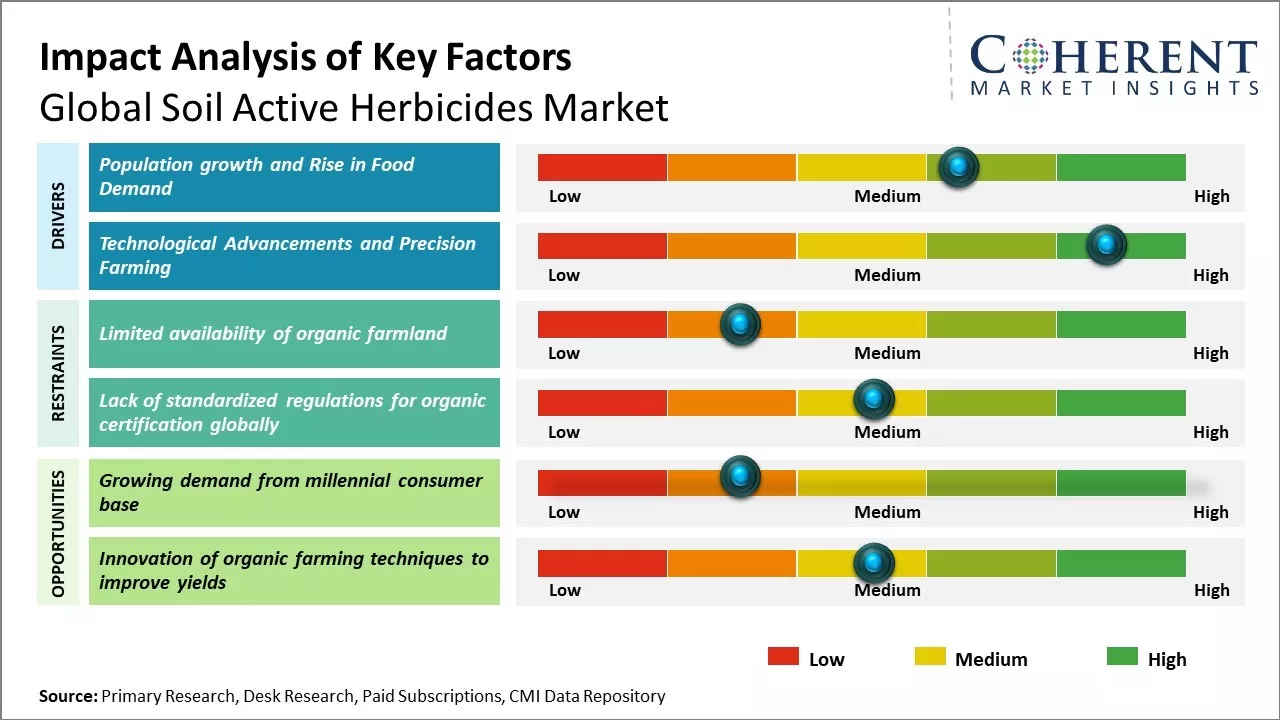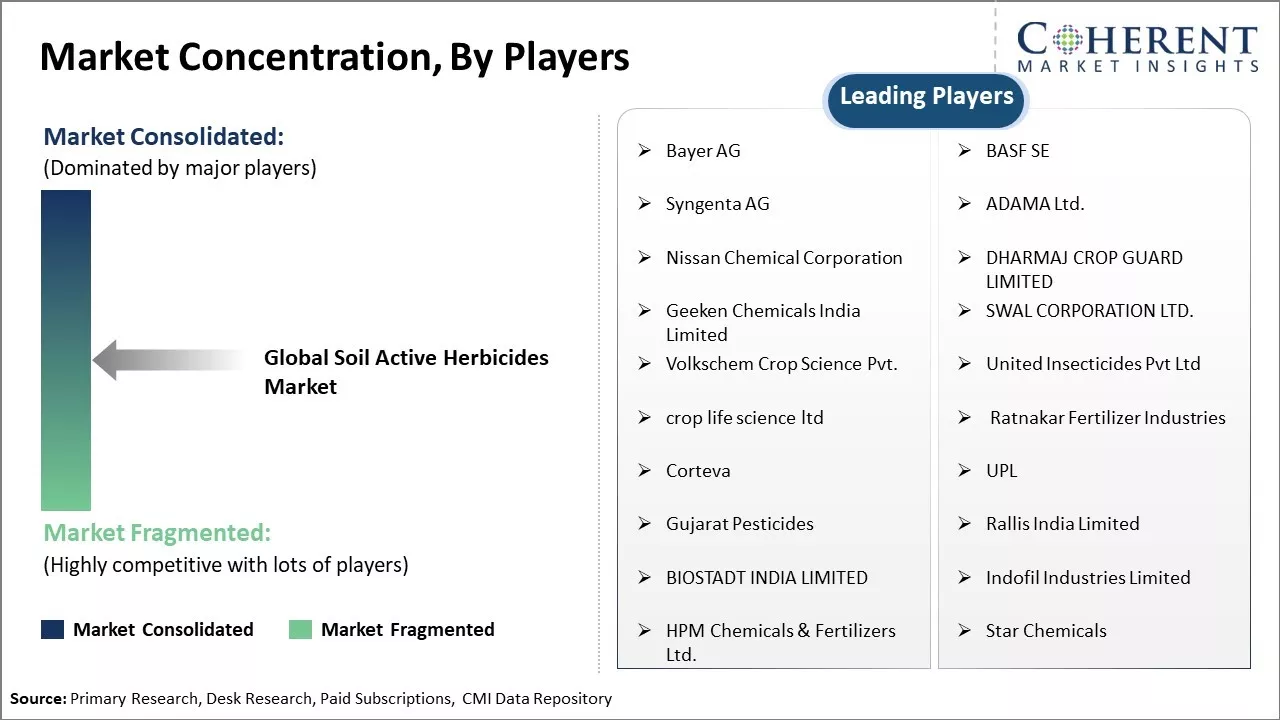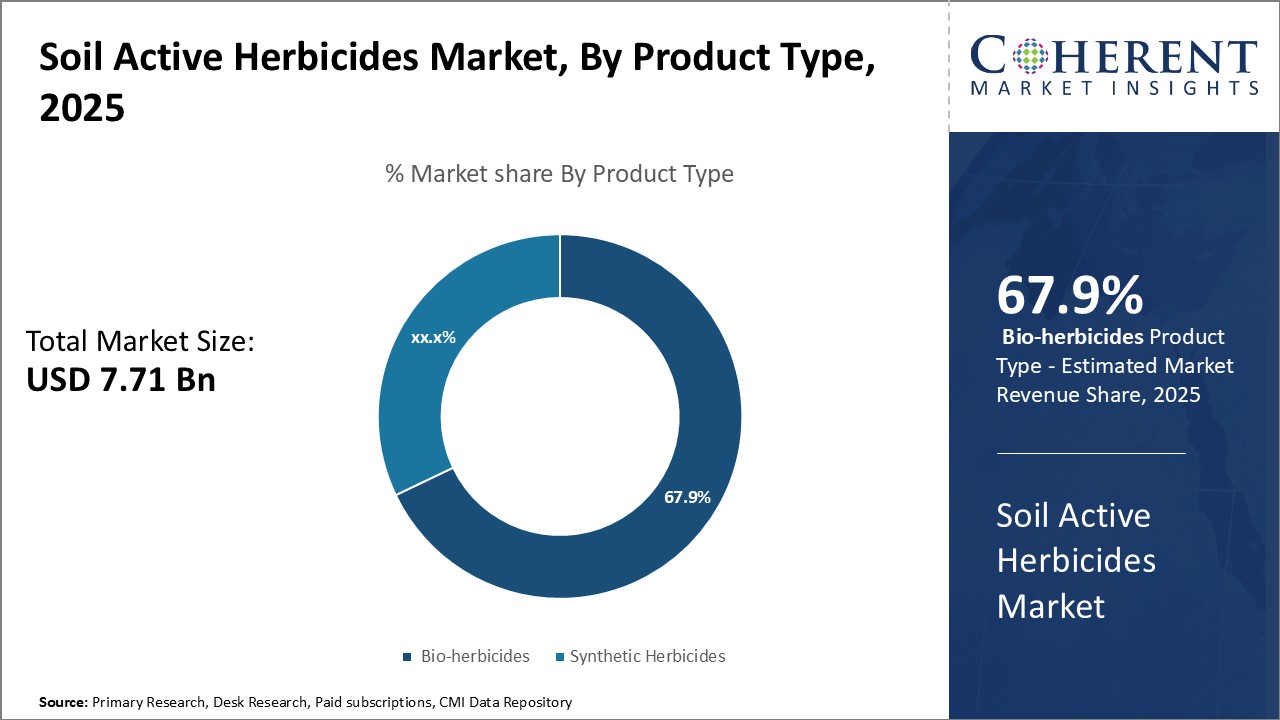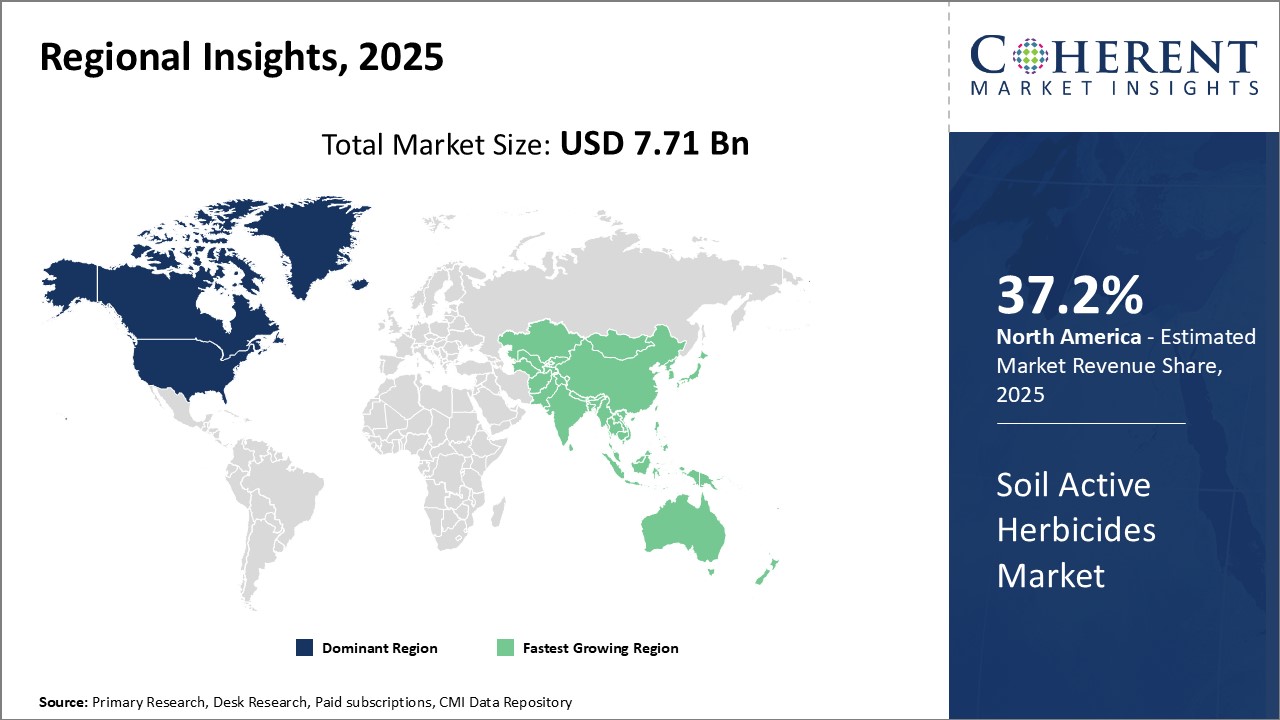The soil active herbicides market is estimated to be valued at USD 7.71 Bn in 2025 and is expected to reach USD 11.30 Bn by 2032, exhibiting a compound annual growth rate (CAGR) of 5.6% from 2025 to 2032.

Discover market dynamics shaping the industry: Download Free Sample
The soil active herbicides market is expected to witness positive growth over the forecast period. The major factors influencing the growth of this market include rising demand for high-quality crops and increased emphasis on boosting agricultural productivity. As population growth continues to rise globally, the demand for food grains and other agricultural commodities is also increasing. This is propelling the use of advanced agrochemicals such as soil active herbicides to maximize crop yields. Additionally, growers are actively adopting precision farming techniques and effective weed management solutions to minimize crop losses. Leading manufacturers are also engaged in new product launches and expansion of their production capacities to cater to the growing demand from the agricultural sector. For instance, investments in the development of herbicide-resistant crops are expected to further drive the demand for compatible soil active herbicides.
Population growth and rise in food demand
As the global population reaches new heights, the demand for food grows exponentially each year. According to UN estimates, the world population is expected to grow from around 7.7 billion to over 9.7 billion by 2050. This surge in population size poses a massive challenge for global food security. Countries will need to ramp up agricultural productivity at an unprecedented rate just to meet the basic calorie needs of the growing population. However, increasing food production is no easy feat. Arable land is scarce and other constraints like water scarcity limit expansion of agricultural lands. At the same time, effects of climate change like erratic weather patterns and increasing pest infestation threaten crop yields. In such a scenario, crop protection products like soil active herbicides play a vital role in maximizing harvests from available farmland. Herbicides help farmers control weeds that compete with crops for nutrients, water, and sunlight. By eliminating weeds, herbicides can increase crop yields significantly. Some studies have shown that weed control with herbicides can boost yields by as much as 20-40%. Thus, with mounting pressure to boost global agricultural output, the demand for crop protection solutions will only intensify in the coming decades. Soil active herbicides, with their ability to boost farm productivity multi-fold, are likely to witness growing adoption. Leading players in the herbicide market will focus on developing more effective weed control formulations and mechanisms that can help farmers everywhere address the formidable challenge of satisfying the world's growing food demands.

Get actionable strategies to beat competition: Download Free Sample
Technological Advancements and Precision Farming
Advancements in agriculture technologies are revolutionizing farming practices around the world. The rising adoption of precision farming techniques allows for more targeted and efficient use of agricultural inputs like seeds, fertilizers, and crop protection chemicals. Precision farming relies on geo-tagging, variable rate technology, and remote sensing to gather field data and customize application of farm inputs for unique field and soil conditions. When it comes to herbicides, precision technologies enable more nuanced weed control strategies. Variable rate applicators allow farmers to variably dose herbicide spray across a field based on spatial variability in weed pressure. Satellite imagery and sensors help map weed distribution for more selective spraying only in infested areas. Geo-tagging and tracking of spray records facilitate audits and compliance with regulations.
Key Takeaways from Analyst:
The soil active herbicides market is expected to see steady growth over the coming years. The rising demand for food due to the increasing global population will drive the need for higher agricultural yields. This will increase the usage of soil active herbicides as they help control weeds and promote crop growth. Crop protection chemicals are indispensable for many farmers globally, ensuring herbicide products remain in demand.
Environmental and health concerns related to herbicide usage could restrain market expansion. Alternative weed control methods involving mechanical removal or organic herbicides may gain interest over time. Within the market, pre-emergence herbicides will continue dominating as they shield crops from weed interference early in their growth cycles. Post-emergence herbicides will likely see higher adoption rates for specialty applications.
North America and Europe will remain other major revenue contributors. Meanwhile, Latin America is positioned favorably due to conducive climatic conditions and rising agricultural mechanization. On the other hand, factors like limited arable land and water shortages may hamper market growth in the Middle East and Africa. Overall, if environmental concerns are addressed responsibly, the soil active herbicides market seems set for steady progress.
Market Challenges: Limited availability of organic farmland
The limited availability of organic farmland is posing a major challenge for the growth of the global soil active herbicides market. Organic farmland makes up a very small percentage of total agricultural land worldwide. According to data from the International Federation of Organic Agriculture Movements, only around 1-2% of the total agricultural land is certified organic farmland. This shortage of organic farmland restricts the scope for adoption of soil active herbicides which are mostly used in organic farming systems. Soil active herbicides are typically used in organic agriculture to control weeds as synthetic chemical herbicides are not permitted in organic farming as per international standards and regulations. However, the limited supply of organic farmland leads to lower demand for herbicides that are suitable for organic use. Many farmers also hesitate to transition to organic practices mainly due to lack of premium price realization for organic produce and insufficient availability of organic farmland in their regions. This adversely impacts the sales potential of soil active herbicides designed for organic agricultural systems.
Market Opportunities: Growing demand from millennial consumer base
The millennial consumer base around the world represents a significant opportunity for the global soil active herbicides market. Millennials, defined as those born between early 1980s to mid-1990s, are now between 25-40 years old and make up over 25% of the population in many major economies. They are highly educated, socially conscious, and financially independent consumers who are actively involved in home and gardening activities. Recent studies show that over 60% of millennial homeowners in Western Europe and North America actively grow fruits, vegetables or landscaping plants in their homes1. This trend is also seen in urban areas of many developing countries in Asia and Latin America as more young people purchase homes and desire private outdoor spaces. With their passion for organic and sustainable living, many millennials prefer using natural and non-chemical products for plant care. Soil active herbicides that are marketed as environmentally-friendly options for weed control without residues are well-aligned with the preferences of this consumer group.

Discover high revenue pocket segments and roadmap to it: Download Free Sample
Insights, by Product Type: Natural Alternatives Drives the Bio-herbicides Demand
In terms of product type, bio-herbicides is expected to contribute 67.9% share of the market in 2025, owing to the growing preference for natural and environment-friendly alternatives. Farmers and crop growers are increasingly looking for sustainable weed control solutions that have minimal impact on the soil health and environment. Bio-herbicides derived from natural sources such as plant extracts fulfill this need well as they are non-toxic, less persistent, and pose negligible risks. The bio-pesticides segment is witnessing a spurt in innovations with various plant-based active ingredients and formulae in the pipeline. Leading manufacturers are investing heavily in R&D to develop highly targeted and effective bio-herbicides that can rival synthetic chemicals. The research is focused on leveraging the allelopathic properties of certain cover crops and plant essential oils. As bio-herbicides decompose rapidly, they leave no harmful residues. This makes them suitable for addressing weed control needs in organic agriculture and integrated pest management systems. Concerns around synthetic herbicide resistance in weeds is another driver for increased bio-herbicides usage. Farmers tend to alternate or combine biocontrols with low-dose synthetic herbicides to delay the onset of resistance in weed populations. As biologicals affect weeds through multiple modes of action simultaneously, they reduce the evolution of resistance as compared to reliance on a single site-specific synthetic herbicide. This factor is boosting the growth prospects of novel bio-herbicides combinations.
Insights, by Mode of Action: Selectivity Drives the Preference for Selective Herbicides
In terms of mode of action, selective herbicides are expected to contribute 69% of the market share in 2025, owing to the need for application versatility and selectivity. Farmers extensively use selective herbicides for broad-acre row crops where the field has a mixture of crop and weed species. Their robust selectivity allows the control of broadleaf weeds or grassy weeds without inflicting any injuries to the crop. This makes them a preferred choice over non-selective or burndown herbicides. Ongoing transformations in agricultural practices point towards the necessity for highly targeted herbicide choices. In precision agriculture and direct seeding systems, the early crop development stages are critical where only broadleaf/grass weeds need to be eliminated to avoid crop damage. The high selectivity of various pre-emergence and post-emergence synthetic and biological selective herbicides addresses this requirement well. New innovations are enabling stronger selectivity through novel proprietary formulations and multiple modes of action. Selective herbicides containing several active ingredients which block different biochemical pathways in weeds while remaining safe for crops, are gaining traction. Their efficacy remains unaffected even with the evolving resistance patterns in different weed species. This makes selective herbicides a mainstay of integrated weed control programs worldwide.
Insights, by Application: Flexibility Boosts Pre-Emergence Herbicides Uptake
In terms of application, pre-emergence herbicides are expected to contribute 36.1% of the market share in 2025, as it offers the most amount of flexibility in terms of weed control timing. Pre-emergence herbicides allow farmers to gain an early season advantage over weeds by establishing long term preventive control. Their preventive mode of action before weed emergence minimizes crop-weed competition through effective residual weed control lasting 4-6 weeks. This is highly beneficial in many crops where post-emergence control options are limited due to crop safety issues. Their flexibility to be used both in pre-plant and at planting situations addressing a wide weed spectrum further boosts their uptake. Modern farmers rely on multiple short term and overlapping pre-emergence applications to maintain season-long control with shifts in weed flora. A robust portfolio of new pre-emergence chemistries and combinations provide longer residual effects and break the resistance patterns in weeds. This has strengthened the preference for pre-emergence herbicides both as standalone and as part of integrated programs including post-emergence controls. The labor and cost savings compared to repeat post-emergence scouting and applications is another plus. Their consistent results and reliability drive sustained demand despite higher upfront costs. Pre-emergence herbicides thus provide a strategic foundation for sustainable and effective soil weed management programs.

Need a Different Region or Segment? Download Free Sample
The North American region currently dominates the global soil active herbicides market. The region is expected to account for a market share of 37.2% in 2025. The large agricultural industry in countries like the U.S. is a major driver of the herbicide demand. Farmers in the Midwest and Great Plains rely heavily on herbicides to control weeds across vast swaths of land dedicated to commodity crops. Stringent regulations and adherence to product labels ensure the safe and effective use of herbicides in the region. Leading crop protection companies have also established extensive distribution networks and retail partnerships to serve herbicide needs. Trade with Mexico further bolsters the regional herbicide consumption.
The Asia Pacific region, on the other hand, is witnessing the fastest growth in the soil active herbicides market. Surging agricultural output to feed rising populations is presenting new opportunities for herbicide sales. Countries such as India and China are encouraging modern farming practices and mechanization. Smallholder farmers are gradually adopting chemical weed control methods as an affordable solution. Local production is increasing as well to drive down costs and improve access to herbicides. Export markets, particularly in Southeast Asia, are also expanding. Additionally, many multinational companies are investing in the region through partnerships and acquisitions to capitalize on future potential. Overall, the developmental trends and improving farm economics in Asia Pacific indicate that the momentum for herbicide demand will continue into the foreseeable future.
Soil Active Herbicides Market Report Coverage
| Report Coverage | Details | ||
|---|---|---|---|
| Base Year: | 2024 | Market Size in 2025: | USD 7.71 Bn |
| Historical Data for: | 2020 To 2024 | Forecast Period: | 2025 To 2032 |
| Forecast Period 2025 to 2032 CAGR: | 5.6% | 2032 Value Projection: | USD 11.30 Bn |
| Geographies covered: |
|
||
| Segments covered: |
|
||
| Companies covered: |
Bayer AG, BASF SE, Syngenta AG, ADAMA Ltd., Nissan Chemical Corporation, DHARMAJ CROP GUARD LIMITED, Geeken Chemicals India Limited , SWAL CORPORATION LTD., Volkschem Crop Science Pvt., United Insecticides Pvt Ltd , crop life science ltd, Ratnakar Fertilizer Industries, Corteva, UPL, Gujarat Pesticides, Rallis India Limited, BIOSTADT INDIA LIMITED, Indofil Industries Limited, HPM Chemicals & Fertilizers Ltd., and Star Chemicals |
||
| Growth Drivers: |
|
||
| Restraints & Challenges: |
|
||
Uncover macros and micros vetted on 75+ parameters: Get instant access to report
*Definition: The soil active herbicides market consists of weed control products that are applied directly to soil before planting or after harvesting of crops. These herbicides work systemically by being absorbed by weed roots from the soil over time. Common active ingredients in soil active herbicides include diuron, linuron, pendimethalin, oryzalin, and benefin which kill weeds by interfering with their ability to produce chlorophyll or disrupt cell division.
Share
Share
About Author
Vidyesh Swar is a seasoned Consultant with a diverse background in market research and business consulting. With over 6 years of experience, Vidyesh has established a strong reputation for his proficiency in market estimations, supplier landscape analysis, and market share assessments for tailored research solution. Using his deep industry knowledge and analytical skills, he provides valuable insights and strategic recommendations, enabling clients to make informed decisions and navigate complex business landscapes.
Missing comfort of reading report in your local language? Find your preferred language :
Transform your Strategy with Exclusive Trending Reports :
Frequently Asked Questions
Joining thousands of companies around the world committed to making the Excellent Business Solutions.
View All Our Clients